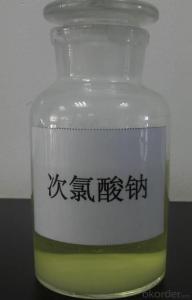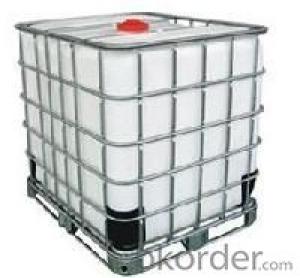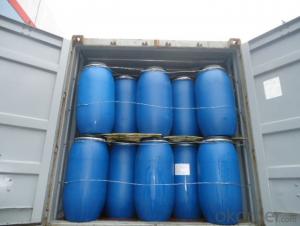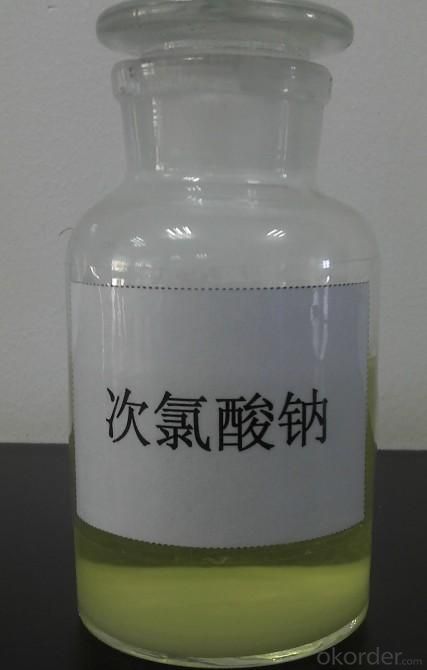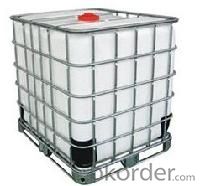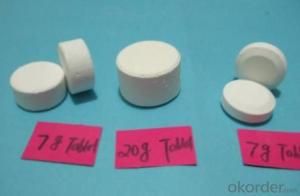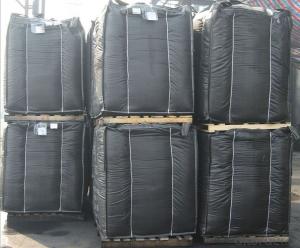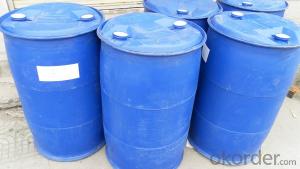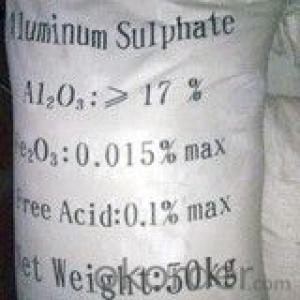Sodium Hypochlorite Plant Quality China Supplier
- Loading Port:
- Tianjin
- Payment Terms:
- TT OR LC
- Min Order Qty:
- 25 m.t.
- Supply Capability:
- 6000 m.t./month
OKorder Service Pledge
OKorder Financial Service
You Might Also Like
Sodium Hypochlorite
CAS NO: 7681-52-9
Chemical Formula: NaClO
Molecular Weight: 74.44
Appearance: Yellow transparent Liquid
Standard: HG/T2498-1993
Specification:
Available Chlorine: 8%-16%
NaOH: 1% Max
Transportation Info:
Class: 8 UN NO: 1791 PG:III
Application:
Disinfection for swimming pool, drinking water, cooling tower and sewage and waste water, food, and farming, hospital, school, station and household etc
Good bleaching and oxidation in paper and dye industry.
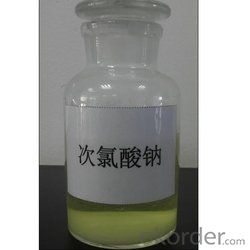
Normal Packing: 30kg drum, 1200kg IBC Tank
| Calcium Hypochlorite | ||
SYNONYMS: | Bleaching powder, Hypochlorous Acid, Calcium Salt; Losantin; Calcium Hypochloride; Chlorinated lime. | ||
FORMULA: | Ca(clo)2 | ||
MOLECULAR WEIGHT: | 142.98 | ||
PROPERTIES: | Appearance white or light-grey power,granule, mixed,tablet | ||
EINECS NO: | 231-908-7 | ||
CAS NO.: | 7778-54-3 | ||
Hazard Class: | 5.1 | ||
UN No.: | 1748 | ||
H.S. CODE: | 2828 1000 | ||
SPECIFICATIONS: | Components: | Guaranteed Analysis | Typical Analysis: |
Available Chlorine: | 65%min | 65.2% | |
Moisture: | 3%max | 2.5% | |
Yearly Loss of Chlorine: | 8% | 8% | |
Calcium Chloride : | 9% | 9% | |
PACKAGING: | Normally in plastic or steel drums lined with inner per bag of 45-50kg II class net each .Can be adaptable in terms of various requirements. | ||
QUANTITY PER CONTAINER: | 20MTS/20’FCL(NON-PALLETIZED) for ocean shipping; | ||
HANDLING & STORAGE: | 1)Should be stored in cool and dry warehouse away from heating sources and avoid direct sunlight. 2) In transportation, contact with such should be avoided as sunlight, heating, moisture, organics, oil and acids. How to handle in case of leakage: Collect in time and seal properly. | ||
RECOMMENDED | 1. For bleaching purpose of wood pulp, silk, cloth and fibre. | ||
- Q: What are the catalysts for making oxygen in chemistry? (At least 8 listed)
- Manganese dioxide, iron oxide (red brick powder), copper oxide, ferrous oxide, iron oxide, activated carbon, egg shell, fresh liver, raw potato chips, etc.
- Q: what is metallocene catalyst technology?
- Metallocene catalyst A transition-metal atom sandwiched between ring structures having a well-defined single catalytic site and well-understood molecular structure used to produce uniform polyolefins with unique structures and physical properties. See also Catalysis; Coordination chemistry; Coordination complexes; Metallocenes; Organometallic compound. In the early 1980s, W. Kaminsky discovered that an appropriate co-catalyst activated metallocene compounds of group 4 metals, that is, titanium, zirconium, and hafnium, for alpha-olefin polymerization, attracting industrial interest. This observation led to the synthesis of a great number of metallocene compounds for the production of polymers already made industrially, such as polyethylene and polypropylene, and new materials. Polymers produced with metallocene catalysts represent a small fraction of the entire polyolefin market, but experts agree that such a fraction will increase rapidly in the future. See also Polymer; Polymerization; Polyolefin resins.
- Q: Chemical Glossary: Catalyst
- The catalyst is a substance that can change the rate of the reaction without changing the standard of the reaction Gibbs free, according to the definition of the International Pure and Applied Chemistry (IUPAC) in 1981, Enthalpy change. This effect is called catalysis. The reaction involving the catalyst is a catalytic reaction.
- Q: pls give one or two catalysts that are used in the industry for example:Rhodium catalyst in a catalytic converter of a car or the Iron catalyst for making ammoniaTHANKS :)
- u . s . a . of america has an excellent style of organic gas. In theory that's accessible to have an electric powered motor force a compressor to take the low stress gas to make it dense adequate to get adequate interior the vehicle to run for a mutually as (in actuality, gas stations with organic gas pumps do it precisely like that, that's no longer trucked to them, we've a pair in Dallas) the real undertaking is that, specific it will be pressurized, requiring a greater perfect tank than propane, that's a liquid interior the tank, and the tank must be a cumbersome cylinder for capability or numerous smaller cylinders area by making use of area. Getting this into the physique of the vehicle devoid of doing away with all the storage/bags area isn't ordinary. And ultimate efforts nevertheless finally end up with the miles in line with fill up being decrease than the gas which inserts in a small area.
- Q: What is the catalyst condition in the chemical equation?
- I studied three methods ~ word which can be used to give me a mailbox to the word text to pass you ~
- Q: Explain how catalysts help to reduce costs in industrial processes !?Thanks
- Catalysts are efficient at converting starting materials to the final products. Since catalysts convert these materials to the product faster, less energy will be used, and often less other materials will be used to complete the process. Both will save the company save time and money. Not to mention the catalyst can be reused, often hundreds of times before it needs to be replaced. Hope that helps!
- Q: Word editor when playing chemical equation = with the above conditions or how to adjust the size of the catalyst, how to make it centered,
- Open the word - insert - object - WPS3.0 formula - and then select the "label arrow template", you can add a catalyst.
- Q: chemistry subject
- I don't think there's just a few of them.
- Q: Why does the CuO catalyze the reaction rate faster and faster when catalyzing the decomposition of hydrogen peroxide or tell me how to make the catalyst catalyst faster
- CuO exothermates when catalyzing the decomposition of hydrogen peroxide, so the reaction becomes faster.
- Q: What is the catalyst called?
- Catalysts induce chemical reactions to change, cause chemical reactions to become faster or slower, or to react chemically at lower temperatures. The catalyst is also known as a catalyst in industry.
Send your message to us
Sodium Hypochlorite Plant Quality China Supplier
- Loading Port:
- Tianjin
- Payment Terms:
- TT OR LC
- Min Order Qty:
- 25 m.t.
- Supply Capability:
- 6000 m.t./month
OKorder Service Pledge
OKorder Financial Service
Similar products
Hot products
Hot Searches
Related keywords
